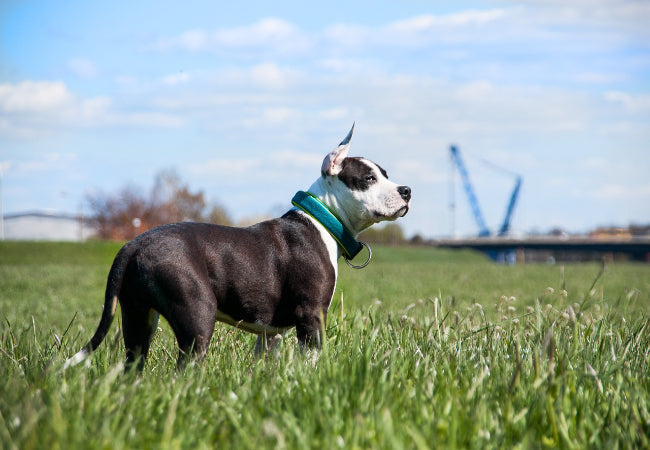Am. Staffordshire Terrier Guide: Health, Training & Care 🐶✨

In this article
Am. Staffordshire Terrier Guide: Health, Training & Care 🐶✨
By Dr. Duncan Houston BVSc
The American Staffordshire Terrier—known as the “AmStaff”—is a stocky, courageous, and affectionate companion that thrives on interaction and purpose. With roots tracing back to 19th-century bull-and-terrier lines, this breed balances muscular power with heart, becoming a loyal family guardian when raised with respect and expert guidance.
📚 Origins & Physical Profile
- History: Developed from English bull-and-terrier crosses in the mid‑1800s, recognized by the AKC in 1936.
- Size: Males ~18–19″ tall, 55–70 lb; females ~17–18″, 40–55 lb—muscular, compact, and balanced.
- Coat: Short, dense, glossy coat in numerous colors—weekly brushing controls shedding.
🧠 Temperament & Personality
AmStaffs are celebrated for their:
- Friendly nature: Warm, affectionate, good with kids—often called “nanny dogs”.
- Confidence: Bold but not aggressive; socialization reduces unwarranted suspicion.
- Trainable: Intelligent, treat-driven, excelling in obedience, agility, and rally.
- Protective edge: Loyal guardians who need proper exposure to other dogs, and training to manage excitement-related behaviors.
🏡 Living Environment & Exercise Needs
Living with an AmStaff means staying active and structured:
- Daily exercise: 60–120 minutes of walking, play, or dog sports.
- Apartment life works—if matched with daily mental & physical activity.
- Best in family settings—bond heavily and dislike long periods of separation, which may prompt chewing or anxiety.
✂️ Grooming & Maintenance
- Weekly brushing with a soft brush removes loose hair—more in spring/fall.
- Bath as needed—short coat dries fast.
- Routine care: weekly ear checks, nail trims, and dental brushing 2–3× per week.
Tip: Use the Ask A Vet app to schedule care tasks and log skin or coat issues.
🍽️ Nutrition & Feeding Guidelines
- Provide 2–3 cups of high-quality, active adult dog food across 2 meals daily.
- Use slow feeders and elevated bowls to reduce bloat risk.
- Supplement joint and skin health with fish oil and glucosamine as required.
- Track monthly weight via Ask A Vet; adjust diet or exercise upon detection of trends.
🩺 Health Concerns & Prevention
The typical lifespan is 12–16 years.
- Hip dysplasia: Moderate risk—screen early, maintain lean weight, use joint support.
- Skin allergies & demodicosis: Common—monitor for itch, redness, hair loss; groom and manage environment. Up to 20% juvenile demodicosis has been reported.
- Cardiac concerns: Rare cardiomyopathy cases—annual listening and screening advised.
- Gastroenteric sensitivity: Food reactions—avoid table scraps, transition diets carefully.
- Breed-specific legislation: Some areas restrict or regulate AmStaffs—check local laws.
Vet protocol: Annual comprehensive checkups including dermatology, orthopedics, weight analysis, allergies, and local compliance requirements—track with Ask A Vet.
🎓 Training & Behavioral Strategies
- Socialize early: From 8–16 weeks—people, pets, situations to build confidence.
- Positive reinforcement: Treats, praise, and Woopf toy rewards reinforce great behavior.
- Impulse control: Teach "sit-wait," recall, leave-it—keeps behavior safe and calm.
- Engage mind + body: Agility, obedience, fetch, tug-of-war to satisfy physical and mental needs.
- Behavior logs: Use Ask A Vet to record and analyze training progress and patterns.
👪 Ideal Owners & Setup
- ✅ Great fit: Active individuals or families, experienced owners, ready to train and care consistently.
- ❌ Less ideal: First-time owners without a support structure, households with small children left unsupervised, or those in BSL-regulated areas without compliance.
📱 Tools That Support Your AmStaff
- Ask A Vet: Health tracking, training logs, care reminders, and vet-chat in one app.
⭐ Case Story – “Bella, the Loving Watchdog”
Bella, a 5-year-old AmStaff, was overprotective and barky. Logging behavior with Ask A Vet revealed triggers during doorbell ringing. We implemented:
- Desensitization drills: Bell + sit + reward.
- Consistent recall games and toy distractions.
- Daily brisk walks and safe, structured off-leash time.
- Check-ins on skin and ears using the app.
Outcome after 6 weeks: Bella’s reactivity reduced by 70%, calm focus improved, and family harmony restored.
🧑⚕️ Final Take from Dr Duncan Houston
The American Staffordshire Terrier is a powerful, affectionate, and intelligent breed—ideal as a family member when raised with love, structure, and veterinary care. Use Ask A Vet to centralize wellness and training. With thoughtful guidance, your AmStaff can thrive physically, mentally, and in your heart.
Next step? Create your dog’s Ask A Vet profile now and begin logging weight, socials, and trainings—then let’s plan a tailor-made exercise and health regime together!






